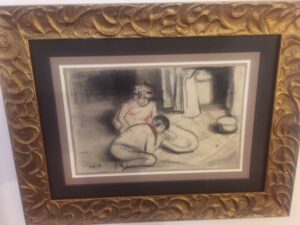 SJ showed me a drawing before she framed it. She thought it an original Diego Rivera when she saw it in Ventura at the Boys and Girls Club Thrift store. She picked it up for $20. Occasionally it is fun to take a chance.
SJ showed me a drawing before she framed it. She thought it an original Diego Rivera when she saw it in Ventura at the Boys and Girls Club Thrift store. She picked it up for $20. Occasionally it is fun to take a chance.
Let me explain how my mind worked as I looked at the piece, which really did look like a work on paper by Diego Rivera, not signed but dated 22 Aug 1928.
The paper looks pulled from one of those flip lengthwise artists’ sketchbooks, not “wove” high quality artist paper, but sketchpad paper. One side shows perforations from the binding, and the other has shaped corners, typical of a sketch book.
Looks like chalk and charcoal on paper
I look for the slight raised and friction-based “pull” of the charcoal and chalk upon paper. It felt a bit raised to my ginger touch. When I look with a loupe, it doesn’t look like pigment laid on paper in a photomechanical process, because I don’t see the dot matrix pattern of a mechanical process print.
When I compare the shape of the DATE letters and the numbers with photos in auction results, they might be in the hand of Rivera. Of course this piece lacks the artist’s signature, and that worries me because he usually signed his work.
What was the artist doing in 1928?
In June 1928 Rivera as he returned from a Communist party celebration in Moscow, journeyed back through Berlin to Mexico. He began working on a mural for the Mexican Ministry of Education, as well as a fresco series at Chapingo. He began thinking of images to use for a 1930 mural commission called “Visions of the History of Mexico.”
So perhaps all these facts allow us to think a lowly scene of a mother and son at a bath on a dirt floor might seem right for the year 1928. The documentary style of an image of the common folk at the date of 1928 feels “right.” If this turns out to be original, the date 1928 might become auspicious, because that year Rivera met Freda Kahlo. That might interest a collector.
If original, why NOT signed?
Usually, an artist signs in two or more cases: he may sign a sketch, perhaps given as a gift, OR as an indication that a work is finished and complete. Usually Rivera signed his sketches, unless he never intended this for anyone else’s eyes….
What’s next? SJ might need a paper analysis; difficult to do if anybody ever glued it to cardboard. Did the artist often do this? Yes, I’ve seen other images glued down, and sold recently.
SJ might contact a few auction houses, send good photos of the work for an estimate. She doesn’t need to sell the piece and won’t need to pay for this, but by the values given, she may get an indication.
I tried to find this image sold at auction since electronic records have been kept, and it has NOT. I searched all known images of prints, multiple, lithographs, and I do NOT see this image. What is the likelihood given these facts above that SJ scored on an original work?
Diego Rivera’s Long Diverse Career
One possibility that it may be “right” is the nature of the artist’s life. Diego Rivera worked in at least five countries, he gave sketches away, and he kept many sketch books. He worked on many murals, paintings, commissions, and was constantly gathering ideas. He lived a long and prolific life, he worked in many styles, he sketched constantly, sometimes in vignettes. The likelihood of finding an original Rivera in a thrift store is perhaps higher than an artist who lived in ONE place, worked in ONE style, in ONE medium, and died EARLY!
What’s this worth if authentic? All comparable sales are SIGNED works, as those are the top level sold at auction, for ANY artist. However, the comparable sales in this size, with similar theme, on sketch paper, in crayon, chalk, or charcoal sell for $1,000-$4,000. She may have found a treasure.
Thanks Elizabeth for insight into your incredibly knowledgable methods- fascinating. Love this.
All best!!